
The Prophet's Mosque is the second mosque built by the Islamic prophet Muhammad in Medina, after the Quba Mosque, as well as the second largest mosque and holiest site in Islam, after the Masjid al-Haram in Mecca, in the Saudi region of the Hejaz. The mosque is located at the heart of Medina, and is a major site of pilgrimage that falls under the purview of the Custodian of the Two Holy Mosques.

The Bajrakli Mosque is a mosque in Belgrade, the capital of Serbia. It is located in Gospodar Jevremova Street in the neighbourhood of Dorćol. It was built around 1575, and is the only mosque in the city out of the 273 that had existed during the time of the Ottoman Empire's rule of Serbia.
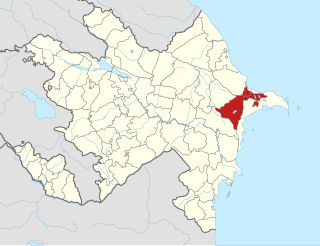
Absheron District is one of the 66 districts of Azerbaijan. Located in the east of the country, it belongs to the Absheron-Khizi Economic Region. The district borders the districts of Khizi, Gobustan, Baku, Hajigabul, Salyan, and the city of Sumgait. Its capital and largest city is Khyrdalan. As of 2020, the district had a population of 214,100. Although the district shares the same name as the Absheron Peninsula, the area covered by the district is not conterminous, being further west and mostly inland.
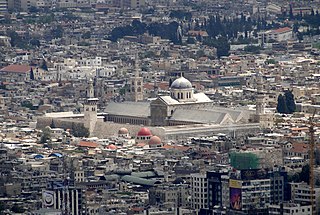
The Umayyad Mosque, also known as the Great Mosque of Damascus, located in the old city of Damascus, the capital of Syria, is one of the largest and oldest mosques in the world. Its religious importance stems from the eschatological reports concerning the mosque, and historic events associated with it. Christian and Muslim tradition alike consider it the burial place of John the Baptist's head, a tradition originating in the 6th century. Two shrines inside the premises commemorate the Islamic prophet Muhammad's grandson Husayn ibn Ali, whose martyrdom is frequently compared to that of John the Baptist and Jesus.

The Palace of the Shirvanshahs is a 15th-century palace built by the Shirvanshahs and described by UNESCO as "one of the pearls of Azerbaijan's architecture". It is located in the Inner City of Baku, Azerbaijan and, together with the Maiden Tower, forms an ensemble of historic monuments inscribed under the UNESCO World Heritage List of Historical Monuments. The complex contains the main building of the palace, Divanhane, the burial-vaults, the shah's mosque with a minaret, Seyid Yahya Bakuvi's mausoleum, south of the palace, a portal in the east, Murad's gate, a reservoir and the remnants of a bath house. Earlier, there was an ancient mosque, next to the mausoleum. There are still ruins of the bath to the west of the tomb.

Old City or Inner City is the historical core of Baku, the capital of Azerbaijan. The Old City is the most ancient part of Baku, which is surrounded by walls. In 2007, the Old City had a population of about 3,000 people. In December 2000, the Old City of Baku, including the Palace of the Shirvanshahs and Maiden Tower, became the first location in Azerbaijan to be classified as a UNESCO World Heritage Site.

Yukhari Govhar Agha Mosque (Azerbaijani: Yuxarı Gövhər Ağa məscidi, is a mosque located in the city of Shusha, Azerbaijan. The mosque also bears the name Boyuk Juma of Govhar Agha.

The Musalla complex, also known as the Musallah Complex or the Musalla of Gawhar Shah, is a former Islamic religious complex located in Herat, Afghanistan, containing examples of Timurid architecture. Much of the 15th-century complex is in ruins today, and the buildings that still stand are in need of restoration. The complex ruins consist of the five Musallah Minarets of Herat, the Mir Ali Sher Navai mausoleum, the Gawhar Shad Mausoleum, and the ruins of a large mosque and a madrasa complex.

Mosque architecture in Indonesia refers to the architectural traditions of mosques built in the archipelago of Indonesia. Initial forms of the mosque, for example, were predominantly built in the vernacular Indonesian architectural style mixed with Hindu, Buddhist or Chinese architectural elements, and notably didn't equip orthodox form of Islamic architectural elements such as dome and minaret. Vernacular architectural style varies depending on the island and region.

Shaki Khan's Mosque, previously First Khan Mosque is an 18th-century Azerbaijani mosque located in the city of Shaki.
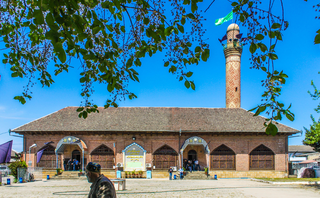
The Boyuk Bazar Mosque is a mosque in the city of Lankaran, Azerbaijan. The mosque was built in 1864 in the Boyuk Bazar neighborhood.

The Kichik Bazar Mosque is a mosque and historical architectural monument located in the center of the Lankaran district of Azerbaijan. The mosque was built in 1904.
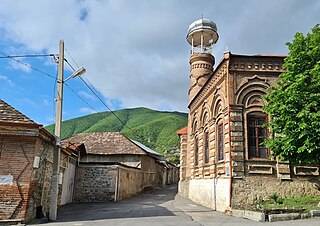
Omar Efendi Mosque is a historical and architectural monument of the 19th century located in the city of Shaki, Azerbaijan.

The Haji Sultanali Mosque is a historical-architectural monument dating back to the early 20th century, located in Baku, Azerbaijan.
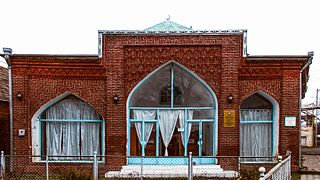
The Ozan Mosque -( Azerbaijani Ozan məscidi ) is a historical and architectural monument of the 19th century in the city of Ganja, Azerbaijan. Ozan Mosque was built in Ganja in 1884.
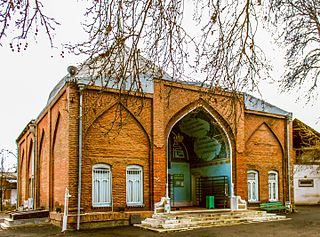
Gazakhlar Mosque is a historical and architectural monument of the 19th century, located in the city of Ganja (Azerbaijan).

Susay Mosque is a historic architectural monument located in Susay village of the Quba District, Azerbaijan.

Kerbelayi Abdulla Mosque is a mosque and historical architectural monument dating back to the 19th century, located at 155 Dilara Aliyeva Street in Baku, the capital city of Azerbaijan. The mosque was built in 1894 by philanthropist Abdulla Zerbaliyev.

Juma Mosque, also known as the Minaret Mosque, is a mosque and historical-architectural monument located in the city of Balakən, Azerbaijan. The construction of the mosque lasted 10 years and was completed in 1877.

Juma Mosque (Qabala) is a historical-architectural monument from the 19th–20th centuries, located in the city of Qabala, Azerbaijan.





























